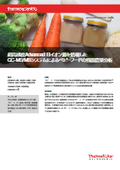[Case Study] Residual Pesticide Analysis of Baby Food Using GC-MS/MS
Quantification of trace pesticides using the highly sensitive Advanced EI ion source compared to conventional ion sources.
The detection and quantification of pesticides, contaminants, and other chemical residues is particularly important when the food is intended for infants. Many pesticide products have a maximum residue limit (MRL) typically set at 10 μg/kg, but the European Union (EU) has established MRLs for certain pesticides banned for use in baby food at 3 to 8 μg/kg. In the worst-case scenario, such pesticides and their metabolites can exceed the acceptable daily intake (ADI) for infants. The high sensitivity and selectivity of GC-MS/MS allow for the detection and quantification of regulated residues even in baby food containing multiple ingredients. This application note presents a case study of the analysis of pesticide residues in baby food using a high-sensitivity Advanced EI ion source. The increased sensitivity allows for the dilution of sample extracts, reduces system contamination, and is expected to enhance laboratory productivity.
basic information
For details, please contact us or refer to the PDF.
Price range
Delivery Time
Applications/Examples of results
For details, please contact us or refer to the PDF.
catalog(3)
Download All CatalogsRecommended products
Distributors
Thermo Fisher Scientific K.K., the Japanese subsidiary of Thermo Fisher Scientific Incorporated, is a sales company for comprehensive system analysis instruments, bio-related equipment, and research reagents. In Japan, it has bases in Yokohama, Tokyo, Osaka, Fukuoka, and Nagoya, handling various analytical instruments including mass spectrometers, various bio-related equipment, measuring instruments, medical devices, lab software, and research reagents.














































